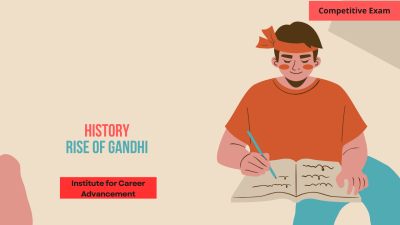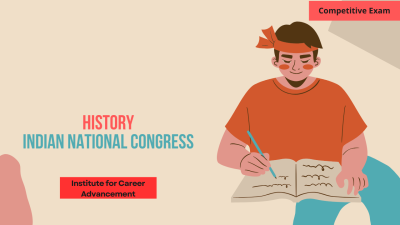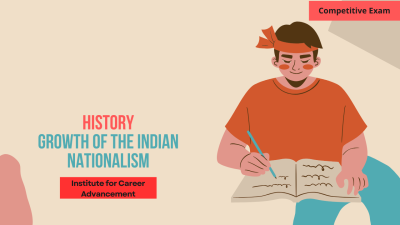Courses


 Compare
Compare
Women played a crucial role in India's national movement for independence, contributing both in the forefront and behind the scenes. They participated in protests, demonstrations, and revolutionary activities, advocating for both national freedom and gender equality. Prominent figures like Sarojini Naidu, Kasturba Gandhi, and Kamaladevi Chattopadhyay, alongside countless unsung women, took part in movements such as the Non-Cooperation Movement, Civil Disobedience, and Quit India Movement. Women also worked in the fields of education, social reform, and healthcare, empowering other women and advancing social change. Their contributions helped shape the political and social landscape of modern India. ভারতের জাতীয় স্বাধীনতা আন্দোলনে মহিলারা গুরুত্বপূর্ণ ভূমিকা পালন করেছিলেন, সামনে এবং পর্দার আড়ালে উভয় ক্ষেত্রেই অবদান রেখেছিলেন। তারা জাতীয় স্বাধীনতা এবং লিঙ্গ সমতা উভয়ের পক্ষে সওয়াল করে প্রতিবাদ, বিক্ষোভ এবং বিপ্লবী কার্যক্রমে অংশ নিয়েছিল। সরোজিনী নাইডু, কস্তুরবা গান্ধী এবং কমলাদেবী চট্টোপাধ্যায়ের মতো বিশিষ্ট ব্যক্তিরা অগণিত অজ্ঞাতনামা মহিলাদের পাশাপাশি অসহযোগ আন্দোলন, আইন অমান্য এবং ভারত ছাড়ো আন্দোলনের মতো আন্দোলনে অংশ নিয়েছিলেন। মহিলারা শিক্ষা, সামাজিক সংস্কার এবং স্বাস্থ্যসেবা, অন্যান্য মহিলাদের ক্ষমতায়ন এবং সামাজিক পরিবর্তনের অগ্রগতির ক্ষেত্রেও কাজ করেছেন। তাঁদের অবদান আধুনিক ভারতের রাজনৈতিক ও সামাজিক প্রেক্ষাপট গঠনে সহায়তা করেছে।
0 Lessons
Hours

 Compare
Compare
The Working Class Movement in Indian modern history emerged in the early 20th century, as industrialization and urbanization began to take root under British colonial rule. Workers in factories, mines, and railways faced exploitation, poor working conditions, and low wages. The movement gained momentum through the establishment of labor unions and the rise of prominent leaders like Subhas Chandra Bose, B.T. Ranadive, and others. Key events included strikes, protests, and the formation of the All India Trade Union Congress (AITUC) in 1920. The movement was intertwined with the Indian independence struggle, as it advocated not only for workers' rights but also for social justice, leading to greater political awareness and the eventual improvement of labor laws in post-independence India. বিংশ শতাব্দীর গোড়ার দিকে ব্রিটিশ ঔপনিবেশিক শাসনের অধীনে শিল্পায়ন ও নগরায়ন শিকড় বিস্তার করতে শুরু করলে ভারতীয় আধুনিক ইতিহাসে শ্রমিক শ্রেণির আন্দোলনের উদ্ভব হয়। কারখানা, খনি এবং রেলপথের শ্রমিকরা শোষণ, দুর্বল কাজের পরিস্থিতি এবং কম মজুরির সম্মুখীন হয়েছিল। শ্রমিক ইউনিয়ন প্রতিষ্ঠা এবং সুভাষ চন্দ্র বসুর (B.T.) মতো বিশিষ্ট নেতাদের উত্থানের মাধ্যমে আন্দোলনটি গতি লাভ করে। রণদিভ এবং অন্যান্যরা। মূল ঘটনাগুলির মধ্যে রয়েছে ধর্মঘট, প্রতিবাদ এবং 1920 সালে সর্বভারতীয় ট্রেড ইউনিয়ন কংগ্রেস (এ. আই. টি. ইউ. সি) গঠন। এই আন্দোলনটি ভারতীয় স্বাধীনতা সংগ্রামের সঙ্গে জড়িত ছিল, কারণ এটি কেবল শ্রমিকদের অধিকারের পক্ষে নয়, সামাজিক ন্যায়বিচারের পক্ষেও ছিল, যা বৃহত্তর রাজনৈতিক সচেতনতা এবং স্বাধীনতা-পরবর্তী ভারতে শ্রম আইনের চূড়ান্ত উন্নতির দিকে পরিচালিত করেছিল।
0 Lessons
Hours

 Compare
Compare
Muslim League Politics refers to the political actions and ideologies associated with the All India Muslim League (AIML), a significant political party in colonial India, founded in 1906. Initially focused on the protection of Muslim rights, the party played a crucial role in the demand for Pakistan and the eventual partition of India in 1947. Under the leadership of Muhammad Ali Jinnah, the Muslim League became a key player in Indian politics, advocating for a separate Muslim-majority state due to concerns about Muslim identity, culture, and political representation in a post-colonial India. The rise of the Muslim League's demand for two-nation theory and its struggle for the creation of Pakistan marked a turning point in Indian history, significantly shaping the trajectory of South Asia's political landscape. মুসলিম লীগের রাজনীতি বলতে 1906 সালে প্রতিষ্ঠিত ঔপনিবেশিক ভারতের একটি উল্লেখযোগ্য রাজনৈতিক দল অল ইন্ডিয়া মুসলিম লীগ (এ. আই. এম. এল)-এর সঙ্গে যুক্ত রাজনৈতিক কার্যকলাপ ও মতাদর্শকে বোঝায়। প্রাথমিকভাবে মুসলিম অধিকার সুরক্ষার দিকে মনোনিবেশ করা, দলটি পাকিস্তানের দাবি এবং 1947 সালে ভারতের বিভাজনের ক্ষেত্রে গুরুত্বপূর্ণ ভূমিকা পালন করেছিল। মুহম্মদ আলী জিন্নাহর নেতৃত্বে মুসলিম লীগ ভারতীয় রাজনীতিতে একটি প্রধান খেলোয়াড় হয়ে ওঠে, একটি উত্তর-ঔপনিবেশিক ভারতে মুসলিম পরিচয়, সংস্কৃতি এবং রাজনৈতিক প্রতিনিধিত্ব সম্পর্কে উদ্বেগের কারণে একটি পৃথক মুসলিম সংখ্যাগরিষ্ঠ রাষ্ট্রের পক্ষে সওয়াল করে। মুসলিম লীগের দ্বি-জাতি তত্ত্বের দাবির উত্থান এবং পাকিস্তান গঠনের জন্য তার সংগ্রাম ভারতীয় ইতিহাসে একটি সন্ধিক্ষণ চিহ্নিত করে, যা দক্ষিণ এশিয়ার রাজনৈতিক দৃশ্যপটের গতিপথকে উল্লেখযোগ্যভাবে রূপ দেয়।
0 Lessons
Hours

 Compare
Compare
Dalit Movements refer to the social, political, and cultural movements aimed at challenging the oppression and discrimination faced by Dalits (historically referred to as "untouchables") in India. These movements have focused on securing civil rights, social justice, and equality for Dalits, who were subjected to systemic exclusion and exploitation under the caste system. The Dalit movement emerged as a response to this caste-based marginalization, advocating for the upliftment of Dalits through education, political participation, land reforms, and the abolition of untouchability. Key figures such as Dr. B.R. Ambedkar, who led the movement for Dalit rights and played a significant role in drafting India’s constitution, are central to these movements. The Dalit struggles have evolved over time, with Ambedkarite, Buddhist, and Marxist ideologies shaping various strands of activism aimed at eliminating caste discrimination and creating a more inclusive society. দলিত আন্দোলন বলতে ভারতে দলিতদের (ঐতিহাসিকভাবে "অস্পৃশ্য" হিসাবে পরিচিত) নিপীড়ন ও বৈষম্যকে চ্যালেঞ্জ করার লক্ষ্যে সামাজিক, রাজনৈতিক এবং সাংস্কৃতিক আন্দোলনকে বোঝায়। এই আন্দোলনগুলি নাগরিক অধিকার, সামাজিক ন্যায়বিচার এবং দলিতদের জন্য সমতা সুরক্ষিত করার দিকে মনোনিবেশ করেছে, যারা বর্ণ ব্যবস্থার অধীনে পদ্ধতিগতভাবে বর্জন ও শোষণের শিকার হয়েছিল। শিক্ষা, রাজনৈতিক অংশগ্রহণ, ভূমি সংস্কার এবং অস্পৃশ্যতা দূরীকরণের মাধ্যমে দলিতদের উত্থানের পক্ষে সওয়াল করে দলিত আন্দোলন এই বর্ণ-ভিত্তিক প্রান্তিককরণের প্রতিক্রিয়া হিসাবে আবির্ভূত হয়েছিল। মূল ব্যক্তিত্ব যেমন Dr. B.R. আম্বেদকর, যিনি দলিত অধিকারের জন্য আন্দোলনের নেতৃত্ব দিয়েছিলেন এবং ভারতের সংবিধানের খসড়া তৈরিতে গুরুত্বপূর্ণ ভূমিকা পালন করেছিলেন, এই আন্দোলনের কেন্দ্রবিন্দু। দলিত সংগ্রামগুলি সময়ের সাথে সাথে বিকশিত হয়েছে, আম্বেদকরবাদী, বৌদ্ধ এবং মার্কসবাদী মতাদর্শগুলি বর্ণ বৈষম্য দূর এবং আরও অন্তর্ভুক্তিমূলক সমাজ গঠনের লক্ষ্যে সক্রিয়তার বিভিন্ন ধারাকে রূপ দিয়েছে।
0 Lessons
Hours

 Compare
Compare
The Rise of Gandhi refers to the period during which Mahatma Gandhi emerged as the central figure in India’s struggle for independence. After returning to India from South Africa in 1915, Gandhi introduced new strategies of non-violent resistance (Satyagraha) and civil disobedience to challenge British colonial rule. His leadership in key movements like the Champaran Satyagraha, the Kheda Satyagraha, and the Non-Cooperation Movement helped galvanize millions of Indians from diverse backgrounds, making him the face of the Indian National Congress and the broader independence movement. Gandhi's emphasis on self-reliance, non-violence, and inclusive leadership redefined the path to freedom for India and left a lasting impact on global civil rights movements. গান্ধীর উত্থান সেই সময়কে বোঝায় যখন মহাত্মা গান্ধী ভারতের স্বাধীনতা সংগ্রামে কেন্দ্রীয় ব্যক্তিত্ব হিসাবে আবির্ভূত হয়েছিলেন। 1915 সালে দক্ষিণ আফ্রিকা থেকে ভারতে ফিরে আসার পর, গান্ধী ব্রিটিশ ঔপনিবেশিক শাসনকে চ্যালেঞ্জ জানাতে অহিংস প্রতিরোধ (সত্যাগ্রহ) এবং আইন অমান্যের নতুন কৌশল চালু করেন। চম্পারণ সত্যাগ্রহ, খেড়া সত্যাগ্রহ এবং অসহযোগ আন্দোলনের মতো মূল আন্দোলনগুলিতে তাঁর নেতৃত্ব বিভিন্ন পটভূমির লক্ষ লক্ষ ভারতীয়কে অনুপ্রাণিত করতে সহায়তা করেছিল, যা তাঁকে ভারতীয় জাতীয় কংগ্রেস এবং বৃহত্তর স্বাধীনতা আন্দোলনের মুখ করে তুলেছিল। আত্মনির্ভরতা, অহিংসা এবং অন্তর্ভুক্তিমূলক নেতৃত্বের উপর গান্ধীর জোর ভারতের স্বাধীনতার পথকে নতুন করে সংজ্ঞায়িত করেছে এবং বিশ্বব্যাপী নাগরিক অধিকার আন্দোলনে স্থায়ী প্রভাব ফেলেছে।
0 Lessons
Hours

 Compare
Compare
Revolutionary Activities in Bengal, Punjab, and Maharashtra were crucial in the struggle for India's independence, marked by the rise of radical groups and individuals who resorted to armed resistance against British colonial rule. Bengal: Bengal became a hotspot for revolutionary activities in the late 19th and early 20th centuries, with groups like Anushilan Samiti and Jugantar promoting armed resistance. Prominent revolutionaries such as Subhas Chandra Bose, Khudiram Bose, and Surya Sen led attacks on British officials and institutions. The Swadeshi Movement (1905) also contributed to the rise of revolutionary sentiments in Bengal, which were further fueled by the repression following the 1905 Partition of Bengal. Punjab: In Punjab, revolutionary activities were driven by discontent over British policies and economic exploitation. Bhagat Singh, Chandrashekhar Azad, and Lala Lajpat Rai were key figures. The Jallianwala Bagh massacre (1919) spurred widespread anger, and groups like the Ghadar Party advocated for violent uprisings against the British. The revolutionary youth in Punjab played an instrumental role in the formation of radical nationalist organizations. Maharashtra: Maharashtra was home to several key revolutionary leaders and movements. The state saw the rise of Veer Savarkar, who advocated for Hindu nationalism, and Bal Gangadhar Tilak, who led the Home Rule Movement. The bombing of the Viceroy's train and attacks on British officials were among the violent tactics employed by groups such as Abhinav Bharat and the Revolutionary Youth League. Maharashtra's revolutionary activities were significant in fostering the radical wing of India's independence movement. These regions contributed to the broader nationalist resistance by offering a radical, often violent alternative to the non-violent methods of the Indian National Congress. ব্রিটিশ ঔপনিবেশিক শাসনের বিরুদ্ধে সশস্ত্র প্রতিরোধের আশ্রয় নেওয়া মৌলবাদী গোষ্ঠী ও ব্যক্তিদের উত্থানের দ্বারা চিহ্নিত ভারতের স্বাধীনতা সংগ্রামে বাংলা, পাঞ্জাব এবং মহারাষ্ট্রে বিপ্লবী কার্যকলাপ অত্যন্ত গুরুত্বপূর্ণ ছিল। বাংলাঃ ঊনবিংশ শতাব্দীর শেষের দিকে এবং বিংশ শতাব্দীর গোড়ার দিকে অনুশীলন সমিতি এবং যুগান্তরের মতো গোষ্ঠীগুলি সশস্ত্র প্রতিরোধের প্রচার করে বিপ্লবমূলক ক্রিয়াকলাপের জন্য বাংলা একটি হটস্পটে পরিণত হয়েছিল। সুভাষ চন্দ্র বসু, খুদিরাম বসু এবং সূর্য সেনের মতো বিশিষ্ট বিপ্লবীরা ব্রিটিশ কর্মকর্তা ও প্রতিষ্ঠানগুলির উপর আক্রমণের নেতৃত্ব দিয়েছিলেন। স্বদেশী আন্দোলন (1905) বাংলায় বিপ্লবী অনুভূতির উত্থানেও অবদান রেখেছিল, যা 1905 সালের বঙ্গভঙ্গের পর দমন-পীড়নের দ্বারা আরও উজ্জীবিত হয়েছিল। পঞ্জাবঃ পঞ্জাবে ব্রিটিশ নীতি ও অর্থনৈতিক শোষণ নিয়ে অসন্তোষের কারণে বিপ্লবী কার্যকলাপ পরিচালিত হয়েছিল। ভগত সিং, চন্দ্রশেখর আজাদ এবং লালা লাজপত রাই ছিলেন প্রধান ব্যক্তিত্ব। জালিয়ানওয়ালাবাগ গণহত্যা (1919) ব্যাপক ক্ষোভের জন্ম দেয় এবং গদর পার্টির মতো দলগুলি ব্রিটিশদের বিরুদ্ধে হিংসাত্মক বিদ্রোহের পক্ষে সওয়াল করে। পাঞ্জাবের বিপ্লবী যুবক-যুবতীরা মৌলবাদী জাতীয়তাবাদী সংগঠন গঠনে গুরুত্বপূর্ণ ভূমিকা পালন করেছিল। মহারাষ্ট্রঃ মহারাষ্ট্রে বেশ কয়েকজন প্রধান বিপ্লবী নেতা ও আন্দোলন ছিল। রাজ্যটি বীর সাভারকরের উত্থান দেখেছিল, যিনি হিন্দু জাতীয়তাবাদের পক্ষে ছিলেন এবং বাল গঙ্গাধর তিলক, যিনি স্বশাসন আন্দোলনের নেতৃত্ব দিয়েছিলেন। ভাইসরয়ের ট্রেনে বোমা হামলা এবং ব্রিটিশ কর্মকর্তাদের উপর হামলা ছিল অভিনব ভারত এবং বিপ্লবী যুব লীগের মতো গোষ্ঠীগুলির দ্বারা ব্যবহৃত সহিংস কৌশলগুলির মধ্যে অন্যতম। ভারতের স্বাধীনতা আন্দোলনের মৌলবাদী শাখাকে গড়ে তোলার ক্ষেত্রে মহারাষ্ট্রের বিপ্লবী কার্যকলাপ উল্লেখযোগ্য ছিল। এই অঞ্চলগুলি ভারতীয় জাতীয় কংগ্রেসের অহিংস পদ্ধতির একটি মৌলবাদী, প্রায়শই হিংসাত্মক বিকল্প প্রস্তাব করে বৃহত্তর জাতীয়তাবাদী প্রতিরোধে অবদান রেখেছিল।
0 Lessons
Hours

 Compare
Compare
The Indian National Congress (INC), founded in 1885, is one of the oldest political parties in India and played a central role in the Indian independence movement. Initially, it aimed to secure political reforms and greater representation for Indians under British rule. Over time, the INC evolved into a key nationalist organization, advocating for full independence from British colonial rule. Under leaders like Bal Gangadhar Tilak, Subhas Chandra Bose, and especially Mahatma Gandhi, the Congress adopted mass mobilization strategies such as non-cooperation and civil disobedience. The INC's efforts were instrumental in uniting Indians across diverse regions and communities, leading to India's independence in 1947. After independence, the INC became the dominant political party in India, shaping the country's early governance and policies. 1885 সালে প্রতিষ্ঠিত ভারতীয় জাতীয় কংগ্রেস (আইএনসি) ভারতের প্রাচীনতম রাজনৈতিক দলগুলির মধ্যে একটি এবং ভারতের স্বাধীনতা আন্দোলনে কেন্দ্রীয় ভূমিকা পালন করে। প্রাথমিকভাবে, এর লক্ষ্য ছিল ব্রিটিশ শাসনের অধীনে ভারতীয়দের জন্য রাজনৈতিক সংস্কার এবং বৃহত্তর প্রতিনিধিত্ব নিশ্চিত করা। সময়ের সাথে সাথে, আইএনসি একটি প্রধান জাতীয়তাবাদী সংস্থায় পরিণত হয়, যা ব্রিটিশ ঔপনিবেশিক শাসন থেকে পূর্ণ স্বাধীনতার পক্ষে সওয়াল করে। বাল গঙ্গাধর তিলক, সুভাষ চন্দ্র বসু এবং বিশেষ করে মহাত্মা গান্ধীর মতো নেতাদের অধীনে কংগ্রেস অসহযোগিতা এবং আইন অমান্যের মতো গণসংহতি কৌশল গ্রহণ করেছিল। কংগ্রেসের প্রচেষ্টা বিভিন্ন অঞ্চল ও সম্প্রদায়ের মধ্যে ভারতীয়দের একত্রিত করার ক্ষেত্রে সহায়ক ছিল, যার ফলে 1947 সালে ভারতের স্বাধীনতা লাভ হয়। স্বাধীনতার পর, আইএনসি ভারতের প্রভাবশালী রাজনৈতিক দলে পরিণত হয়, যা দেশের প্রাথমিক শাসন ও নীতিগুলিকে রূপ দেয়।
0 Lessons
Hours

 Compare
Compare
The growth of Indian nationalism was a gradual process that took place over the 19th and early 20th centuries as a response to British colonial rule. Several factors contributed to its development: Economic Exploitation: British policies led to economic hardship, deindustrialization, and widespread poverty in India, which fueled resentment and a desire for change. Social and Cultural Reforms: Reform movements, such as the Brahmo Samaj and Arya Samaj, promoted social justice and cultural revival, which helped foster a sense of national pride and unity. Western Education: The introduction of Western-style education exposed Indians to liberal ideas like democracy and equality, inspiring them to challenge British rule. Political Organizations: The formation of the Indian National Congress (INC) in 1885 gave Indians a platform to voice their political demands, initially seeking reforms within the colonial system. Nationalist Movements: The increasing economic and political awareness led to organized protests and movements, such as the Non-Cooperation Movement and the Civil Disobedience Movement, which eventually contributed to India's independence in 1947. Overall, Indian nationalism grew out of a collective resistance to British colonial policies and the desire for self-rule, with the efforts of leaders like Mahatma Gandhi and Jawaharlal Nehru playing a crucial role. ভারতীয় জাতীয়তাবাদের বিকাশ একটি ক্রমান্বয়ে প্রক্রিয়া ছিল যা 19শ এবং 20শ শতাব্দীর গোড়ার দিকে ব্রিটিশ ঔপনিবেশিক শাসনের প্রতিক্রিয়া হিসাবে সংঘটিত হয়েছিল। বেশ কয়েকটি কারণ এর বিকাশে অবদান রেখেছেঃ অর্থনৈতিক শোষণঃ ব্রিটিশ নীতিগুলি ভারতে অর্থনৈতিক দুর্দশা, শিল্পায়ন ও ব্যাপক দারিদ্র্যের দিকে পরিচালিত করেছিল, যা অসন্তোষ এবং পরিবর্তনের আকাঙ্ক্ষাকে উস্কে দিয়েছিল। সামাজিক ও সাংস্কৃতিক সংস্কারঃ ব্রাহ্ম সমাজ ও আর্য সমাজের মতো সংস্কার আন্দোলনগুলি সামাজিক ন্যায়বিচার ও সাংস্কৃতিক পুনরুজ্জীবনের প্রচার করেছিল, যা জাতীয় গর্ব ও ঐক্যের অনুভূতি গড়ে তুলতে সহায়তা করেছিল। পাশ্চাত্য শিক্ষাঃ পাশ্চাত্য ধাঁচের শিক্ষার প্রবর্তন ভারতীয়দের গণতন্ত্র ও সমতার মতো উদার ধারণার প্রতি উন্মুক্ত করে দেয়, যা তাদের ব্রিটিশ শাসনকে চ্যালেঞ্জ জানাতে অনুপ্রাণিত করে। রাজনৈতিক সংগঠনঃ 1885 সালে ভারতীয় জাতীয় কংগ্রেস (আইএনসি) গঠন ভারতীয়দের তাদের রাজনৈতিক দাবিগুলি তুলে ধরার জন্য একটি মঞ্চ প্রদান করে, প্রাথমিকভাবে ঔপনিবেশিক ব্যবস্থার মধ্যে সংস্কারের চেষ্টা করে। জাতীয়তাবাদী আন্দোলনঃ ক্রমবর্ধমান অর্থনৈতিক ও রাজনৈতিক সচেতনতা অসহযোগ আন্দোলন এবং আইন অমান্য আন্দোলনের মতো সংগঠিত প্রতিবাদ ও আন্দোলনের দিকে পরিচালিত করে, যা শেষ পর্যন্ত 1947 সালে ভারতের স্বাধীনতায় অবদান রাখে। সামগ্রিকভাবে, মহাত্মা গান্ধী এবং জওহরলাল নেহরুর মতো নেতাদের প্রচেষ্টায় গুরুত্বপূর্ণ ভূমিকা পালন করে ব্রিটিশ ঔপনিবেশিক নীতির বিরুদ্ধে সম্মিলিত প্রতিরোধ এবং স্বায়ত্তশাসনের আকাঙ্ক্ষা থেকে ভারতীয় জাতীয়তাবাদের বিকাশ ঘটে।
0 Lessons
Hours

 Compare
Compare
The Revolt of 1857, also known as the First War of Indian Independence or the Sepoy Mutiny, was a significant uprising against British colonial rule in India. It began in May 1857 with the rebellion of Indian soldiers (sepoys) in the British East India Company's army, primarily in Meerut, and quickly spread to other regions such as Delhi, Kanpur, Lucknow, and Jhansi. The revolt was fueled by various grievances, including the introduction of new rifle cartridges that offended religious sentiments, as well as political, economic, and social discontent with British policies. The rebellion saw key leaders like Bahadur Shah Zafar, Rani Lakshmibai, and Nana Saheb fighting against British forces. Although the revolt ultimately failed, it marked the first large-scale resistance against British rule in India. Following the suppression of the uprising, British control of India shifted from the East India Company to direct British Crown rule, initiating the period known as the British Raj. The Revolt of 1857 is often regarded as the beginning of India’s struggle for independence, as it sparked nationalist sentiments that would later contribute to India’s eventual freedom in 1947. 1857 সালের বিদ্রোহ, যা ভারতের প্রথম স্বাধীনতা যুদ্ধ বা সিপাহী বিদ্রোহ নামেও পরিচিত, ভারতে ব্রিটিশ ঔপনিবেশিক শাসনের বিরুদ্ধে একটি উল্লেখযোগ্য বিদ্রোহ ছিল। এটি 1857 সালের মে মাসে ব্রিটিশ ইস্ট ইন্ডিয়া কোম্পানির সেনাবাহিনীতে ভারতীয় সৈন্যদের (সিপাহী) বিদ্রোহের সাথে শুরু হয়, প্রাথমিকভাবে মীরাট-এ, এবং দ্রুত দিল্লি, কানপুর, লখনউ এবং ঝাঁসির মতো অন্যান্য অঞ্চলে ছড়িয়ে পড়ে। ধর্মীয় অনুভূতিতে আঘাত করা নতুন রাইফেল কার্তুজের প্রবর্তন, পাশাপাশি ব্রিটিশ নীতির প্রতি রাজনৈতিক, অর্থনৈতিক ও সামাজিক অসন্তোষ সহ বিভিন্ন অভিযোগের কারণে এই বিদ্রোহের সূত্রপাত হয়। এই বিদ্রোহে বাহাদুর শাহ জাফর, রানী লক্ষ্মীবাঈ এবং নানা সাহেবের মতো প্রধান নেতারা ব্রিটিশ বাহিনীর বিরুদ্ধে লড়াই করেছিলেন। যদিও বিদ্রোহটি শেষ পর্যন্ত ব্যর্থ হয়েছিল, এটি ভারতে ব্রিটিশ শাসনের বিরুদ্ধে প্রথম বড় আকারের প্রতিরোধকে চিহ্নিত করেছিল। বিদ্রোহ দমন করার পর, ভারতের ব্রিটিশ নিয়ন্ত্রণ ইস্ট ইন্ডিয়া কোম্পানি থেকে সরাসরি ব্রিটিশ ক্রাউন শাসনে স্থানান্তরিত হয়, যা ব্রিটিশ রাজ নামে পরিচিত সময়ের সূচনা করে। 1857 সালের বিদ্রোহকে প্রায়শই ভারতের স্বাধীনতা সংগ্রামের সূচনা হিসাবে বিবেচনা করা হয়, কারণ এটি জাতীয়তাবাদী অনুভূতির সূত্রপাত করেছিল যা পরে 1947 সালে ভারতের শেষ স্বাধীনতায় অবদান রাখবে।
0 Lessons
Hours